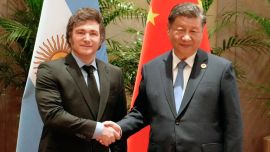Short of hard currency, Argentina's already fragile economy is now taking a beating from nature.
The worst drought in almost 100 years has decimated critical soy, wheat and corn production, its main source of wealth from the fertile pampas.
Soy and wheat crops were halved this year, while maize yield was cut by more than a third, according to official projections, slashing Argentina's exports in a sector crucial for the public purse.
In Lima, 100 kilometres northwest of the capital, much of the soy will not be harvested because the low yield and quality of the grain make the work economically unviable, explains agronomist and agricultural engineer Jaime Mestre.
The drought, now running for three straight years, has reduced the reserves of humidity in the soil to five percent.
Most of the maize plants are dry in Lima. When separating the corn from the cob, the grain is frayed and shrivelled.
With rainfall 50 percent lower than usual, whatever is there to be harvested will likely be of lower quality.
"They could not develop due to lack of water and the high temperatures. They do not justify the cost of a combine harvester," indicates Mestre, measuring yield at "15 percent of the historic average."
"We are 40 days away from sowing winter wheat and we have no humidity in the soil," a critical factor representing up to 60 percent of potential yield, he explains.
Bad timing
Adding to three-digit inflation and a burdensome debt of US$44 billion with the International Monetary Fund (IMF), the drought could not have come at a worse time for Latin America's third-biggest economy.
A few days ago in Washington, during a visit to see US President Joe Biden, President Alberto Fernández highlighted the worst drought suffered by Argentina since 1929 and the IMF conceded more flexible targets for the accumulation of international reserves, which have lost some US$5.5 billion so far this year.
The United States is the nation with the most voting rights at the IMF, which subsequently announced a US$5.4-billion disbursement to Argentina as part of its loan programme.
The IMF insisted, however, that Argentina needed "a stronger policy package... to safeguard stability, address setbacks and secure programme objectives" against the backdrop of "an increasingly severe drought, rising inflation [and] weak reserve coverage."
To stimulate farming exports and boost monetary reserves, the government has announced a new temporary plan fixing a new exchange rate of 300 pesos per dollar for some agricultural products, an intermediate figure between the official exchange rate of some 215 pesos and 400 pesos or more on the parallel markets.
Argentina is one of the main exporters of soy oil and flour, a sector netting the taxman some US$10 billion annually.
Exports of grain and derivatives reached US$43.363 billion in the 2021-2022 harvest but the impact of the drought has wrecked the projections for this harvest, of which half the soy and 35 percent of the maize has been lost.
Rosario Stock Exchange economist Tomás Rodríguez Zurro estimates the overall loss to the economy of Argentina's poor grain-growing season will be about US$20 billion – almost three percentage points of GDP.
"Less production rounds out in less transport, less oil consumption and an increase in forage costs to feed cattle, as well as less income for rural contractors," said Rodríguez Zurro.
Soy, maize and wheat
According to the Rosario Stock Exchange, Argentina’s soy industry – the largest agricultural sector – will have its lowest production figures in 23 years, earning US$7.3 billion less than last year.
"The true situation will be seen when the combine harvesters enter the fields," says Mestre, who considers that the analysts underestimate the gravity of the panorama left by the drought.
In the core zone of the fertile pampas "rainfall has been half of the normal" level, reports Rodríguez Zurro.
The 25 million tons of soy which this harvest is expected to produce would mark the lowest since 1999-2000.
"It’s practically half of what was expected when sowing started and 40 percent less than the last harvest," indicates the economist.
The situation will oblige increased imports for the production of soy flour and oil.
"The temporary imports to supply the soy oil industry in this harvest will be a new record," added Rodríguez Zurro.
The net exports of the soy complex – exports minus imports – would thus total US$11.5 billion this year in comparison with the US$20.8 billion of the previous harvest, he explains.
Meanwhile, wheat production has been halved.
"The harvest will be 11.5 million tons when it had been 23 million last year," forecasts Rodríguez Zurro.
Maize has dropped off 35 percent.
"A production of 35 million tons has been estimated versus the 54 million projected when sowing began in September," the economist reports.
To the loss of tonnage should be added the lower quality of the grain, which will distance Argentina from export standards," warned Mestre.
"This is not a problem that will be solved if it starts to rain today," the experts explains, mentioning the lack of credit and an inflation "which changes costs every day."
The country's more rural interior will feel the pain the most, he adds.
Farming "will need at least three years to even out the losses. Inland towns are where the lack of economic movement is most felt," he warned.
by Magali Cervantes & Sonia Avalos, AFP



















Comments